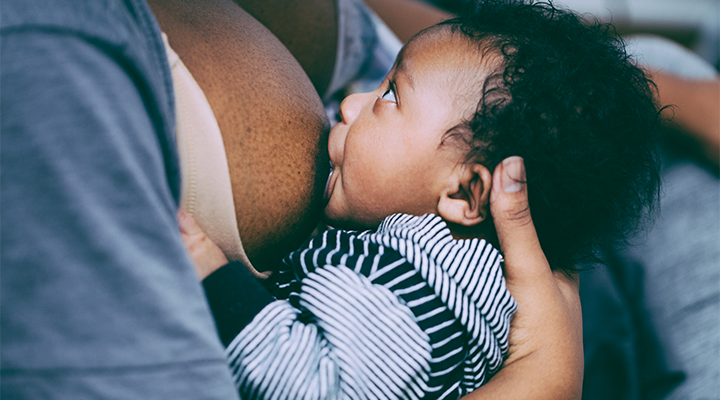Feeding Basics
Learn about the typical feeding routines of a newborn baby. As you read, keep in mind that every baby is different, and yours may eat a little more or a little less than what is outlined here. If you have any questions or concerns about your baby's eating habits, your baby's doctor will be there to help.
What Does My Baby Eat?
Your newborn should only eat breast milk or formula. At around 6 months, you will begin introducing solid foods (in addition to breast milk or formula). You do not need to give your baby any additional water or food before then. The only supplement you may need to give your baby is vitamin D. Your baby's doctor will give you more information on this.
 TIP FOR PARENTS
TIP FOR PARENTS
Check out these 8 helpful hints for feeding your baby from Mayo Clinic.
How Do I Know if My Baby Is Hungry?
When your baby is hungry, they might:

CRY

SUCK ON THEIR HANDS OR FINGERS

TURN TOWARD YOU WHEN YOU TOUCH THEIR FACE

MAKE SUCKING NOISES

NUZZLE AGAINST YOUR CHEST

STICK OUT THEIR TONGUE
For more guidance on how and when to feed your baby, learn about responsive feeding at HealthyChildren.org.
How Much Should My Baby Eat?
BREASTFED BABIES
Follow your baby's hunger cues. Breastfed babies typically eat every two to three hours (including overnight) for 10 to 15 minutes on each breast.
FORMULA-FED BABIES
Your doctor and your baby's doctor will be great resources for breastfeeding questions. Your birthing hospital may have lactation consultants who can give you helpful tips while you're in the hospital, and you can have a lactation consultant come to your home for a private visit. You can also call the women's health breastfeeding line to get answers to your questions right away at 800-994-9662.
How Do I Know if My Baby Is Getting Enough Milk?
The best way to make sure your baby is eating enough is to check for six wet diapers a day and to track their weight with their doctor.
Quick Guide
Follow your baby’s hunger cues but expect the following general eating guidelines:

BREASTFED BABIES
8–12 feedings per day
Nursing sessions every 2-3 hours for 20-30 minutes per feeding
FORMULA-FED BABIES
1–3 oz. formula every 2–4 hours
First few Weeks
At least 4 oz. every 4 hours
1 month old
24–32 oz. over 4–5 feedings a day
By 6 months old
 IN-DEPTH INFO
IN-DEPTH INFO
Learn more with these breastfeeding FAQs from KidsHealth.
Breastfeeding
Breastfeeding is the natural way to feed your baby, but that doesn't mean it's easy. It's a learning process for you and your baby, and it may take weeks before you get the hang of it—and that's normal! If you're feeling lost or confused along the way, there are many people who can help.
Your doctor and your baby's doctor will be great resources for breastfeeding questions. Your birthing hospital may have lactation consultants who can give you helpful tips while you're in the hospital, and you can have a lactation consultant come to your home for a private visit. You can also call the women's health breastfeeding line to get answers to your questions right away at 800-994-9662.
 TIP FOR PARENTS
TIP FOR PARENTS
You are not alone, it will get so much easier, and you're already doing great!
How to Breastfeed Your Baby
The most important part of breastfeeding is ensuring your baby can properly latch. You may have been given help with this in the hospital, but if you have any trouble when you get home, do not hesitate to call your doctor, your baby's doctor, or a lactation consultant.
Here are a few tips:
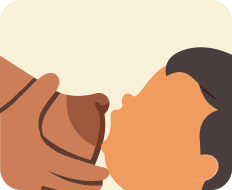
Bring your baby close enough to your breast so they can find your areola without effort.
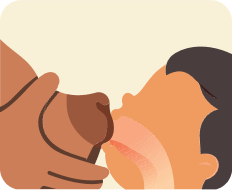
Stimulate your baby’s upper lip with your nipple until their mouth opens very wide.
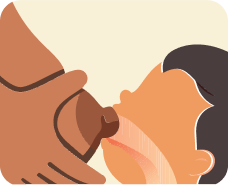
Your baby’s chin and lower lip should be the first thing to make contact with your breast.
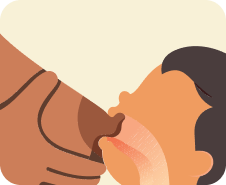
Your baby’s lip must be fully turned out and wrapped firmly against your areola.
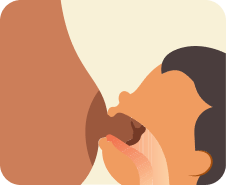
Stimulate your baby’s upper lip with your nipple until their mouth opens very wide.
Breastfeeding Positions
There are many different breastfeeding positions, and it can take time to find the best option for you and your baby. If one position isn’t working, try another! Soon enough you’ll find the right one.
SIDE-LYING CRADLE
FOOTBALL
CRADLE HOLD
SIDE LYING
What will I need if I want to pump breast milk?
You will need a breast pump and breast milk storage bags. There are many excellent breast pumps available, and many are covered by insurance. If you qualify for WIC, they may be able to provide you with a breast pump. If you have any questions about finding a pump, you can talk to your baby’s doctor or the hospital where you delivered—there are many options.
Quick Guide
Pumped or expressed breast milk can be stored for later use. Follow these guidelines:
STORAGE TYPE / STORAGE TIME:
Room temperature, 77ºF (25ºC) or colder
Up to 4 hours
Cooler with frozen ice packs
Up to 24 hours
Refrigerator set to 40ºF (4ºC) or below
Best within 4 days, but can last up to 8 days
Freezer set to 0ºF (-18ºC) or below
Best within 6 months, but can last up to 12 months
Deep freezer set to -10ºF (-23ºC)or below
Up to 12 months
Clearly label breast milk with a date, time, and amount before freezing.
Thaw milk in a bowl of warm water. Never use your microwave
Clearly label breast milk with a date, time, and amount before freezing.
Freeze breast milk in amounts your baby will eat to avoid waste
 TIP FOR PARENTS
TIP FOR PARENTS
The more you breastfeed, the more milk you will make.
The advantages and challenges of breastfeeding
SOME ADVANTAGES OF BREAST MILK AND BREASTFEEDING INCLUDE:
Ideal nutrition for yourbaby
- Perfect balance of fats, sugars, and proteins.
- Easier to digest than formula.
- Less likely to lead to obesity from overfeeding.
Helps keep your baby from getting sick
- Breast milk is full of antibodies that protect against a variety of infections
Can be more cost-effective and convenient
- No need to worry about the cost of formula or about supplies running low.
- When breastfeeding, milk is always on hand and ready at the right temperature.
- No trip to the store or online order required.
A meaningful bonding experience
- Breastfeeding is a special way for a mother and her baby to bond.
SOME CHALLENGES YOU MIGHT FACE IF BREASTFEEDING:
Only the baby’s mom can breastfeed
- This can be especially challenging if she has to go back to work or if other issues arise that keep her from being with the baby full time.
- Breast milk can be pumped so other caregivers can still feed the baby, but this does require storing the milk and getting it ready ahead of time.
Breastfeeding can be uncomfortable, especially at first
- This usually improves with time and practice.
Not always an options for mom’s with certain health concerns
- Such as when taking certain medications or with specific illnesses (such as HIV).
Increased risk of injury or safety issues
- Overheated breastmilk can cause burns.
Formula Feeding
Although there are many benefits to breastfeeding, it may not be the right option for you, and that’s okay! Formula is a good alternative and will give your baby all of the nutrients they need. All that matters is that your baby is fed, whether that’s with breast milk or formula.
 TIP FOR PARENTS
TIP FOR PARENTS
With so many formula options available, it’s best to consult your baby’s doctor with any questions.
How do I choose which formula to give my baby?
There are many formula brands to choose from, and it can be hard to know which will be best for your baby. If you started formula while you were in the hospital, you can continue using the brand that the hospital offered. If you haven’t started formula yet and need help choosing, ask your baby’s doctor for a recommendation.
 TIP FOR PARENTS
TIP FOR PARENTS
Not sure which type to buy? Get the facts about infant formula from WebMD.
How will I know if my baby needs a different formula?
Most babies do very well with standard infant formulas, and it is best to choose one kind of formula and stick with it. It is normal for babies to be gassy, spit up, and fuss when they poop. But if you think your baby is uncomfortable, spitting up more than they should, or not drinking their formula, you should call your baby’s doctor. It may be time for a change.
Here are some signs that your baby might be having issues with their formula:
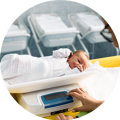
NOT GAINING ENOUGH WEIGHT
Here are some signs that your baby might be having issues with their formula:
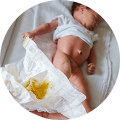
BLOODY POOP

FREQUENT STRAINING
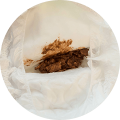
HARD POOP
Here are some signs that your baby might be having issues with their formula:

FREQUENT VOMITING

RECURRENT HIVES

SEVERE ECZEMA
Tracking your baby’s eating and diaper changes
In the early days with a newborn, it can be helpful to keep track of when and how much they eat, pee, and poop. This will help you see what is normal and what is not. If you need to discuss anything with your doctor, you will have everything written down in one place. Once feedings are well established, there is no need to keep tracking unless you have specific concerns. Some things you might want to track:
FEEDING
- Time of feed (when it started)
- If you’re breastfeeding, which breast your baby nursed on
- If you’re bottle-feeding, how many ounces your baby ate at each feeding
- If you’re pumping, how many ounces you pumped during a session.
DIAPERS
- Time of diaper change
- Whether it was pee, poop, or both
- If anything looks unusual
 TIP FOR PARENTS
TIP FOR PARENTS
There are many apps that make it easy to track your baby’s feedings and diaper changes.
Additional Reading
Going Home With Baby
Here's what to know about the first few days after coming home from the hospital.
Sleep
Know what to expect and get tips on helping your baby sleep safely and soundly.
Crying
Understand why babies cry, how you can soothe them, and when to call for extra help.
